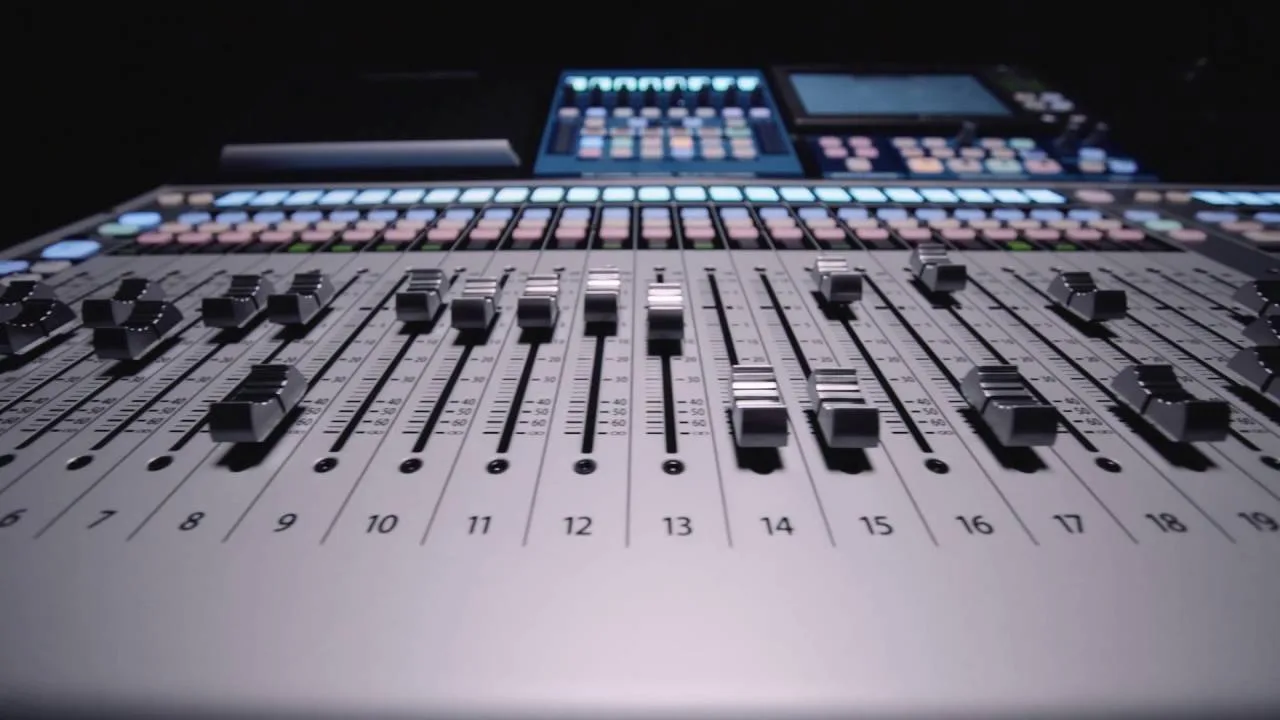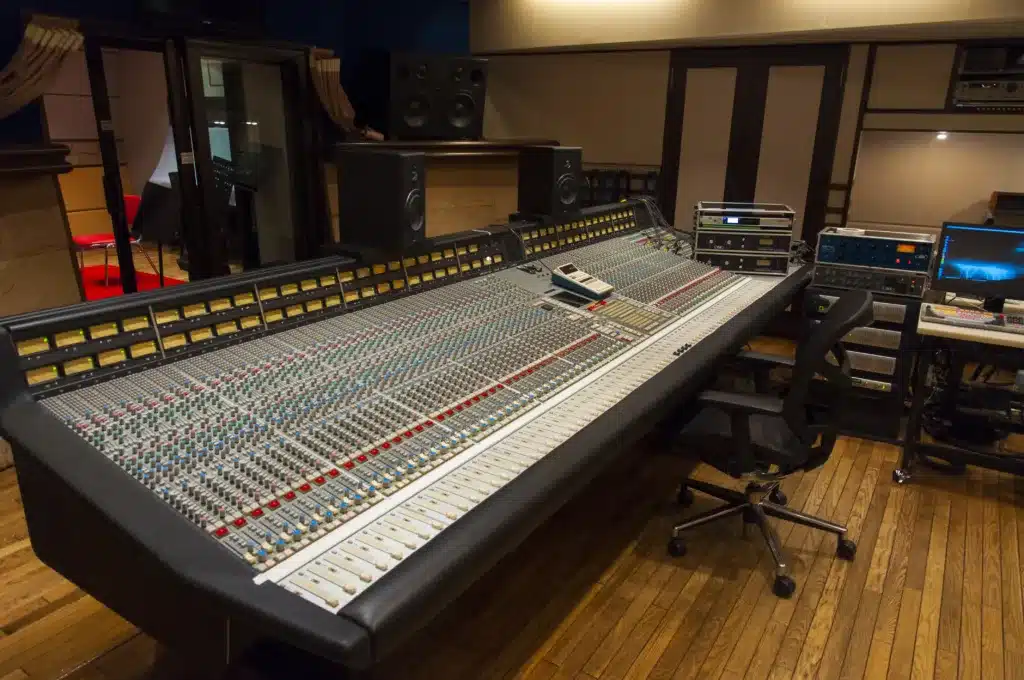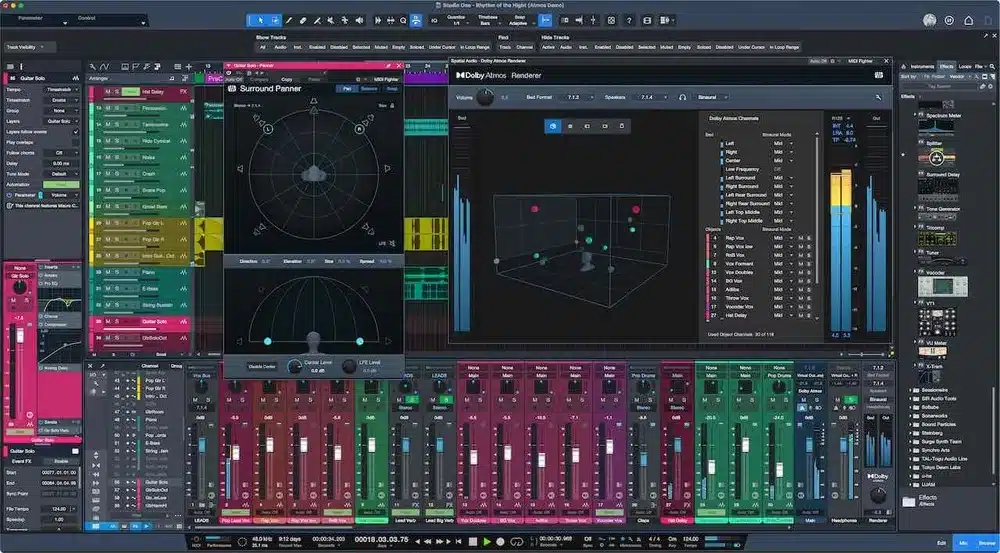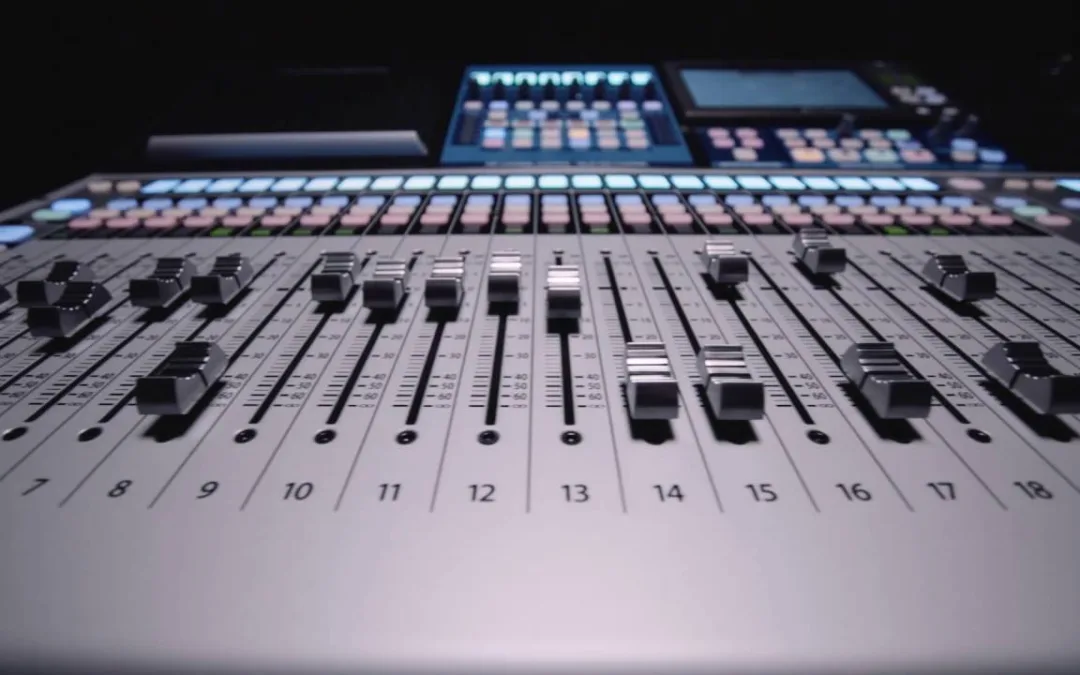Selecting the right audio mixer is crucial for achieving the best results in mixing and recording. In this comprehensive guide, I will walk you through the key factors to consider when choosing an audio mixer. Whether you are a live sound engineer or recording artist or need a portable sound system, this guide will provide you with the essential information to make an informed decision.

Key Takeaways:
- Choosing the best audio mixer involves considering factors such as channel count, connection types, aux buses, analog or digital, onboard signal processing, and recording options.
- There are different types of mixers, including analog, digital, and software mixers, each with their own advantages and disadvantages.
- Analog mixers are known for their simplicity, affordability, and warm analog sound.
- Digital mixers offer advanced features, extensive signal processing capabilities, and the ability to save and recall mixer settings.
- Software mixers are virtual mixing consoles that run on a computer, providing extensive mixing capabilities and integration with digital audio workstations.
What is an Audio Mixer?
An audio mixer is a versatile device that plays a crucial role in the world of audio production. It allows you to combine audio signals from various sources, such as microphones, instruments, and playback devices, and control the balance between them. The mixed signal can then be sent to a loudspeaker system for amplification or a recording device for capturing the final audio output.
With an audio mixer, you can finely adjust the volume levels of each input signal, ensuring a smooth and balanced mix. This control over signal balance is essential for achieving the desired sound quality in different scenarios, whether it’s a live performance or a studio recording.
By using an audio mixer, you gain:
- The ability to adjust the volume levels of multiple audio signals
- Control over the balance between different signals
- The capability to add various effects to each signal
- The option to route the mixed signal to a loudspeaker system for amplification or a recording device for capturing
The audio mixer is the control center of any sound system, allowing you to create the perfect mix by fine-tuning and blending the different audio elements. Whether you are a live sound engineer refining the sound for an audience or a recording artist creating a polished studio recording, an audio mixer is invaluable.
Control Balance and Mixing Signals
One of the primary functions of an audio mixer is to control the balance between different audio signals. This balance is essential for achieving a cohesive and harmonious sound. With an audio mixer, you can adjust the volume levels of each signal independently, giving you complete control over the mix.
By adjusting the balance between signals, you can highlight specific audio sources or create a more uniform blend. For example, in a live band setting, you may want to boost the volume of the lead vocalist’s microphone during a solo while slightly reducing the guitar and keyboard levels to create a balanced mix. The audio mixer allows you to make these adjustments in real time, responding to the dynamic needs of the performance.
Furthermore, an audio mixer enables you to apply various effects to each signal. Effects such as reverb, delay, and equalization can enhance the sound and add depth and texture to individual instruments or vocals. This level of control empowers you to shape the overall sonic character of the mix, ensuring it aligns with the desired artistic vision.
Loudspeaker System and Recording Device
Once the audio signals have been mixed and balanced, the resulting mixed signal is sent to either a loudspeaker system or a recording device, depending on the intended purpose.
When directing the mixed signal to a loudspeaker system, the audio mixer ensures that each signal’s volume and balance are suited for optimal amplification and distribution to the venue’s audience. The sound engineer has the ability to make adjustments on the fly, adapting to the venue’s acoustics and the audience’s preferences. This allows for a tailor-made listening experience and ensures the mix accurately translates to the listener’s ears.
When using an audio mixer in a recording scenario, the mixed signal is routed to a recording device, such as a digital audio workstation or a dedicated multi-track recorder. This enables the capture of the final audio mix for further processing, editing, or mixing during post-production.
Image:
| Key Functions of an Audio Mixer | |
|---|---|
| Combining audio signals from multiple sources | ✔️ |
| Controlling the balance between signals | ✔️ |
| Adjusting volume levels of individual signals | ✔️ |
| Applying various effects to each signal | ✔️ |
| Routing mixed signal to a loudspeaker system | ✔️ |
| Routing mixed signal to a recording device | ✔️ |
Key Factors to Consider When Choosing an Audio Mixer
When it comes to selecting the right audio mixer, there are several key factors that you need to consider. These factors will help ensure that you choose a mixer that meets your specific needs and requirements. Let’s take a closer look at these key factors:
1. Channel Count
The channel count refers to the number of sources that can be connected to the mixer simultaneously. This is an important consideration, especially if you work with multiple audio sources. A higher channel count allows for greater flexibility and the ability to mix more sources at once.
2. Connection Types
The connection types available on the mixer are vital in determining what sources you can connect. For example, some mixers come with microphone preamps for connecting microphones, while others have line inputs for connecting line-level sources. Ensure that the mixer you choose has the appropriate connection types for your needs.
3. Aux Buses
Aux buses are essential for creating monitor mixes. These mixes are crucial for providing musicians and performers with personalized monitor feeds during live performances. The number of aux busesdetermines how many independent monitor mixes you can create.
4. Analog or Digital
Choosing between an analog or digital mixer is a significant decision. Analog mixers offer a warm, classic sound and are often more affordable. On the other hand, digital mixers provide advanced features, extensive signal processing capabilities, and scene recall functionality.
5. Onboard Signal Processing
Consider the onboard signal processing capabilities of the mixer. This includes built-in effects, equalizers, compressors, and other processing tools. Having these onboard can save you from needing external gear and streamline your workflow.
6. Recording Options
If you plan on using the mixer for recording purposes, consider its options. Some mixers provide multitrack recording capabilities, allowing you to capture individual input channels alongside the main mix. This can be beneficial for later editing and mixing.

Solid State Logic Analog Mixing Console
By carefully considering these key factors, you can find an audio mixer that suits your specific needs and helps you achieve the best possible sound quality.
Analog Mixers
In the world of audio mixers, analog mixers hold a special place. They are favored by both live sound engineers and recording artists for their simplicity, affordability, and warm analog sound. Unlike their digital counterparts, analog mixers utilize analog circuitry to process audio signals, delivering a classic and organic sound experience.
One of the standout features of analog mixers is the EQ control available on each channel. This allows you to fine-tune the frequency response of individual audio sources, shaping the overall sound to your liking. Whether you’re boosting the bass on a vocal track or carving out the midrange for a guitar solo, the EQ controls on analog mixers give you precise control over your mix.
Another advantage of analog mixers is the presence of onboard effects processors. These built-in effects allow you to add spatial effects like reverb or delay to your audio signals without the need for external equipment. Whether you’re adding a touch of ambiance to a vocal performance or creating an immersive space for an instrument, the onboard effects processor on an analog mixer expands your creative possibilities.
But that’s not all – some analog mixers even offer multitrack recording capabilities. With the ability to capture individual input channels along with the main mix, you can achieve a higher level of flexibility during the post-production process. This feature is particularly valuable for recording artists who want to have full control over each element in their mix.
Now, let’s take a closer look at the advantages and features that analog mixers bring to the table:
| Advantages of Analog Mixers |
|---|
| 1. Simplicity and ease of use |
| 2. Cost-effective option |
| 3. Warm analog sound |
| 4. EQ controls on each channel |
| 5. Onboard effects processors |
| 6. Multitrack recording capabilities |
As technology continues to advance, analog mixers remain a trusted choice for those seeking a straightforward and reliable audio mixing solution. With their analog circuitry, EQ controls, onboard effects processors, and potential for multitrack recording, analog mixers provide a versatile tool for both live performance and studio recording.
Digital Mixers
Digital mixers are highly versatile and offer advanced features that surpass analog mixers in terms of flexibility and signal processing capabilities. They employ digital signal processors (DSPs) to route audio signals, control levels, and apply various effects. These mixers often come equipped with built-in effects, equalizers, compressors, and other signal processors, eliminating the need for additional external gear.
One of the key advantages of digital mixers is the ability to save and recall mixer settings, allowing for quick and easy scene recall. This feature is especially beneficial in complex shows and theatrical productions where multiple audio setups may be required. By saving different scenes, you can seamlessly transition between performances without the need for manual adjustments.
Additionally, digital mixers offer remote control capabilities, giving you the convenience of adjusting settings wirelessly from anywhere in the venue. With wireless control, you have the freedom to roam and make real-time adjustments without being confined to the mixing console. This is particularly useful for sound engineers and technicians who need to monitor and adjust audio levels in different parts of the venue.
| Advantages of Digital Mixers | Disadvantages of Digital Mixers |
|---|---|
|
|
Digital mixers are particularly well-suited for applications that require extensive signal processing, such as complex live shows, theatrical productions, and recording studios. Their ability to control and manipulate audio signals with precision makes them an indispensable tool for achieving professional sound quality.
Software Mixers

Studio One 6.5
Software mixers are virtual mixing consoles running on a computer or digital audio workstation(DAW) software like Studio One. They offer extensive mixing capabilities and are commonly used in recording studios for their versatility and convenience.
Connecting audio interfaces to your computer allows you to control multiple channels and apply various effects and processing within the software. This flexibility allows for precise control over your mix, enabling you to achieve professional-level sound quality.
Software mixers are especially well-suited for complex recordings that require a large number of channels. They can handle the demands of multi-track recordings, providing the necessary tools for managing each individual audio source.
These virtual mixers often come with a wide range of plugins and virtual instruments, giving you access to an extensive library of sounds and effects. This expands the possibilities for sound manipulation and production, allowing you to unleash your creativity and craft unique sonic landscapes.
With software mixers, you have the power to sculpt your sound with precision, adjusting levels, applying EQ and dynamics processing, and creating spatial effects to shape the final mix according to your artistic vision.
So if you’re looking for an audio mixing solution with extensive capabilities, look no further than software mixers. They offer a world of possibilities for sound engineers, producers, and musicians alike.
| Advantages of Software Mixers | Disadvantages of Software Mixers |
|---|---|
|
|
How to Choose the Right Mixer for Your Needs
Choosing the right mixer depends on your specific needs and applications. Whether you’re working with live sound, recording, or setting up a portable sound system, selecting the right mixer is crucial for achieving optimal audio quality and performance.
Live Sound
When it comes to live sound, several factors need to be considered to ensure a seamless and impactful performance. These factors include:
- The size of the venue: Determine whether you need a compact mixer for small venues or a larger console for bigger stages.
- Number of input channels required: Assess the number of microphones, instruments, and other audio sources that need to be connected to the mixer.
- Portability: If you frequently move your equipment from one location to another, a lightweight and portable mixer would be ideal.
Recording
If you’re primarily focused on recording, your mixer requirements will differ slightly. Consider the following factors:
- Number of input channels: Determine the number of simultaneous audio sources you need to record.
- Signal processing capabilities: Evaluate the mixer’s built-in EQ, dynamics control, and other effects to enhance your recordings.
- Compatibility with your digital audio workstation (DAW): Ensure that the mixer seamlessly integrates with your recording setup for smooth workflow.
Portable Sound System
For setting up a portable sound system in environments such as churches, schools, or businesses, there are specific features you should consider:
- Analog mixer with enough inputs: Look for a mixer with sufficient input channels to accommodate microphones, instruments, and playback devices.
- Powered speakers: Choose a mixer that can connect and power external speakers for convenient and portable sound reinforcement.
| Application | Mixer Type | Key Features |
|---|---|---|
| Live Sound | Analog or digitalmixer | Compact size, sufficient input channels, portability |
| Recording | Digital mixer | Extensive signal processing, compatibility with DAW |
| Portable Sound System | Analog mixer | Enough inputs, compatibility with powered speakers |
By considering these factors, you can choose the right mixer that perfectly aligns with your specific needs, whether you are an acoustic musician, a professional rock band, a church, school, or businessin need of a quality audio solution.
Now that you clearly understand how to choose the right mixer, you can confidently select the perfect audio mixing solution for your requirements.
Conclusion
After exploring the comprehensive guide to choosing the best audio mixer, it is clear that selecting the right mixer involves careful consideration of several key factors. You can make an informed decision that meets your needs by evaluating aspects such as channel count, connection types, aux buses, analog or digital options, onboard signal processing, and recording capabilities.
Whether you are a live sound engineer, recording artist, or in need of a portable sound system, this audio mixer buying guide has provided you with the essential information to find the best audio mixer. By understanding the importance of each factor and assessing your requirements, you can confidently choose the perfect mixer that will enhance your sound production and mixing experience.
Remember, the best audio mixer is the one that aligns with your unique needs and preferences. So take your time, do thorough research, and make a choice that will elevate the quality of your sound production journey.
FAQ
What is an audio mixer?
An audio mixer is a device that allows you to combine audio signals from multiple sources and control the balance between these signals before sending the mixed signal to a loudspeaker system or recording device.
What are the key factors to consider when choosing an audio mixer?
The key factors to consider when choosing an audio mixer include the channel count, connection types, aux buses, analog or digital, onboard signal processing, and recording options.
What are analog mixers?
Analog mixers utilize analog circuitry to process audio signals and offer features such as EQ on each channel and onboard effects processors. They are known for their simplicity, affordability, and warm analog sound.
What are digital mixers?
Digital mixers use digital signal processing to route, control levels, and apply various effects to audio signals. They offer advanced features, scene recall, and wireless remote control options. Digital mixers are ideal for complex shows and situations requiring extensive signal processing.
What are software mixers?
Software mixers are virtual mixing consoles that run on a computer or DAW software. They offer extensive mixing capabilities and are commonly used in recording studios, allowing control over multiple channels and the application of various effects and processing within the software.
How do I choose the right audio mixer for my needs?
Choosing the right audio mixer depends on factors such as your specific needs and applications. Consideration should be given to the venue size, number of input channels required, and the need for portability. For example, a powered mixer may be sufficient for smaller gigs and acoustic performances, while larger venues may require non-powered mixers and separate powered speakers.






